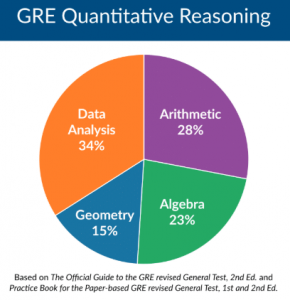Quantitative Reasoning – GRE Mathematics Section
It is the numbers that rule the world. They are used everywhere and you cannot escape it by adopting any ornate tricks on the earth. The GRE exam syllabus is no different. Quantitative Reasoning is one of the three sections in the exam and though it is perceived to be less tough than its Verbal counterpart, it also has some tricks and spoofs up its sleeve.
For many test-takers coming from a non-mathematics academic background, the GRE quantitative reasoning syllabus might seem vast as it covers a myriad of topics. Besides, the GRE exam paper is section- adaptive, and the timing for each section is highly limited. All these reasons contribute to the perception of Quantitative Reasoning being unscorable and skewed towards engineers or science graduates.
In this article, we will give detailed knowledge about the GRE Quantitative Reasoning, including its question types, duration, scoring pattern, and sample examples. Refer to this article for any information you need regarding this section.
The objective of the GRE Quant Section
Before proceeding with learning about the questions and syllabus, it is important to understand what is the objective of a particular section in an exam. The GRE exam is designed to assess the test-takers’ logical ability, their potential to analyze information and make sense or draw a pattern from the data to derive conclusions. The Quantitative Reasoning section is no different.
The main objective of the GRE Quant section is to measure a candidate’s ability to:
- Make sense of Numbers
- Apply mathematical formulas and find answers to given problems
- Understand and interpret quantitative data
Paper Format
- Computer-Based
- 2 sections- 40 questions- 70 minutes. Around 20 questions and duration of 35 minutes for each section
- Paper-Based
- 2 sections- 50 questions- 80 minutes
The score range is 130-170, which is the same as that of the Verbal Section. The sections are divided topic wise and are quite simple as it is the repetition of your 10th-grade mathematics with some tweaks.
However, the difficult part here is the timings of the exam and its denominations associated with each section of the questions. In all, you have 35 minutes for performing in the quantitative reasoning section and there are 20 long questions under it. On average, you get 1.5 minutes to answer a particular quantitative reasoning question with the help of an online calculator.
Quantitative Reasoning Topics
The GRE exam primarily tests four topics in this section. While the weightage of topics changes each year, there is a basic pattern to them which is also elaborated in the official GRE guide.
Arithmetic section
In simple words, it tests your basic understanding of maths. The questions in this section will be based on multiple topics like decimals, integers, fractions, square roots, cube roots, LCM (least common multiple), HCF (Highest common factor), prime numbers, even numbers, and the likes. However, the questions will be fundamental in nature, and arithmetic is generally considered as the easiest part of the quantitative reasoning section.
Algebra section
This section also tests various concepts, including but not limited to functions, equations, and inequalities; linear, quadratic and simultaneous equations; factorials and exponents. The key to scoring well in this section is practicing enough question types. While the questions are not itself difficult, they can be time-consuming. So keep an eye on the clock while doing your GRE preparation for this section. Also, give sufficient practice tests to get used to the online calculator as you will need that in both the arithmetic and algebra sections.
Geometry section
The main topics under Geometry are circles, triangles, quadrilaterals, polygons, parallel and perpendicular lines, three-dimensional figures, the Pythagorean theorem, and angle measurement in degrees. The GRE exam does not test proofs of theorem and construction. While preparing for the geometry section, remember that it will not be possible to understand all question types, unlike algebra. So focus on the fundamentals and practice extensively. The Quantitative Reasoning section will not have any question which tests concepts beyond your high school mathematics. So it will not be difficult for you to solve the questions of any of the three above mentioned sections. However, solving them within time might be difficult. And that is why it is important to give lots of practice tests and analyze the results with your mentors.
Data Analysis section
This section is slightly different from the previous ones. And this is primarily because it is probably the first time you are encountering this question format. The questions are in a set pattern. The main purpose of the data analysis questions is to assess your ability to derive meaningful patterns from random data. So, you might be given a specific organization data and asked to analyze its performance over the years. You might also be asked to analyze a competitor’s performance and find out why they are doing better. While this sounds complex, the level of questions is again rudimentary. So the data will be straight-forward but you have to do a lot of calculations for finding out the right answer. This section is time-consuming and you should avoid hurrying through it as a small calculation mistake will result in the whole set of answers being wrong.
Sample Data Analysis Question:
9th Grade Students at Millbrook High School
Boys Girls
Enrolled in Spanish 12 13
Not Enrolled in Spanish 19 16
Approximately what percent of the 9th-grade girls at Millbrook High School are enrolled in Spanish?
(A) 21%
(B) 37%
(C) 45%
(D) 50%
(E) 57%
Quantitative Reasoning Question Types
Quantitative Comparison
In this type of question format, the two quantities (“Quantity A” and “Quantity B”) will be given. Based on the information given in the question, you have to determine whether:
(A) Quantity A is greater.
(B) Quantity B is greater.
(C) The two quantities are equal.
(D) The relationship cannot be determined from the information given.
While solving quantitative comparison, you have to test more than one value for finding out whether option (D) is applicable. If you are taking numerical values for solving algebra questions, take more than one test case for coming to a conclusion. Note also that Quantitative Comparison questions are very often more interested in testing weird cases and exceptions to rules than they are in testing your knowledge of straightforward cases.
Numeric Entry

As apparent from the name itself, numeric entry type questions will not have any options given. You have to calculate and put your own answer in the space given. If it is a fraction, then you need not break it down to the simplest form. For example, if the simplest form is 1/4, you can write 25/100. This type of question will have only one correct answer. Check carefully if you need to round the answer.
- Pay attention to units such as feet or miles, to orders of magnitude such as millions or billions, and to percents as compared with decimals.
- There can be labels/ headings to indicate the type of answer that is required
- The answer can be either an integer/decimal/ fraction
Multiple Choice
 This question format can again have two types:
This question format can again have two types:
Selecting one choice from a list of five choices
Selecting one or more choices from a list of choices given
The question directions will specify whether it is a single answer choice question or multiple answer choice. However, in the case of multiple answer choices, you have to figure out how many options are correct.
These cover the question types and topics that are most common in the GRE Quantitative Reasoning. While preparing for this section, keep in mind that the key to scoring well is practice and understanding the different question types. Many test-takers face problems with the online calculator, so practice using that while giving your mocks.
Some common tips to keep in mind:
- Check the ETS guide for learning about this year’s paper format and practice the full-length tests given
- Use the rough sheet for your calculation so that you need less time, also there are fewer chances of mistake
All the best! Keep Practicing and you will rock the GRE exam!



















Leave a Reply
You must be logged in to post a comment.